knickerhawk
Member
- Joined
- Jan 7, 2025
- Messages
- 7
A/k/a "wow and flutter"!Is that where you carry your turntable to different parts of the room during testing?
A/k/a "wow and flutter"!Is that where you carry your turntable to different parts of the room during testing?
I see it vice versa - i dealt with two issues at the same time.That's an option, but it seems like a less optimal approach - especially if you're already dealing with bass issues that would be compounded by biasing the sub with more gain. Correct me if I'm thinking about this the wrong way.
I see now that your approach was discussed in the big "Room Correction" thread, so probably not worth rehashing the pros and cons. Suffice it to say, your approach worked well for your particular setup and room, which is the main thing. As always...YMMV!I see it vice versa - i dealt with two issues at the same time.
For me it works perfectly…
I don't believe the cancelation you are seeing is a necessary byproduct of individual channel room correction.I just tried this again but using unmodified B&K target curve for each speaker and as usual I see a dip in the final stereo result around 150Hz.
If I use stereo room correction then I don't get this dip so is independent channel room correction really a better method?
View attachment 22107
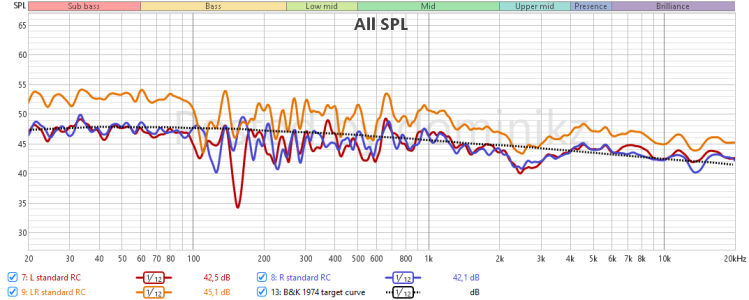
Maybe left and right channel are somehow not in phase at 150hz and are cancelling each other?I just tried this again but using unmodified B&K target curve for each speaker and as usual I see a dip in the final stereo result around 150Hz.
If I use stereo room correction then I don't get this dip so is independent channel room correction really a better method?
View attachment 22107
It is quite a wide dip though.Maybe left and right channel are somehow not in phase at 150hz and are cancelling each other?
You seem to have the opposite, a dip in the left channel which isn't also in the L + R response.I don't believe the cancelation you are seeing is a necessary byproduct of individual channel room correction.
E.g. I usually don't get this in my system:
View attachment 22121
How do your measurements look without any RC/EQ (each channel and both playing together)?
Have you tried comparing per-channel phase responses in this frequency range?
Do you have a subwoofer? It looks like there's a phase issue, as if you have a crossover set at around 120 Hz on your sub, and then it's rolled off at the fourth order, which is causing the phase to shift relative to the main system.I just tried this again but using unmodified B&K target curve for each speaker and as usual I see a dip in the final stereo result around 150Hz.
If I use stereo room correction then I don't get this dip so is independent channel room correction really a better method?
You can see the stereo response with no eq here. There is a dip but not as wide.I don't believe the cancelation you are seeing is a necessary byproduct of individual channel room correction.
E.g. I usually don't get this in my system:
View attachment 22121
How do your measurements look without any RC/EQ (each channel and both playing together)?
Have you tried comparing per-channel phase responses in this frequency range?
The sub crossover is set to 80Hz.Do you have a subwoofer? It looks like there's a phase issue, as if you have a crossover set at around 120 Hz on your sub, and then it's rolled off at the fourth order, which is causing the phase to shift relative to the main system.
Make of this what you will. I never understand speaker phase plots.I don't believe the cancelation you are seeing is a necessary byproduct of individual channel room correction.
E.g. I usually don't get this in my system:
View attachment 22121
How do your measurements look without any RC/EQ (each channel and both playing together)?
Have you tried comparing per-channel phase responses in this frequency range?
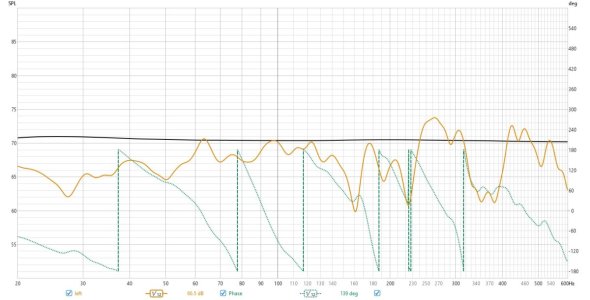

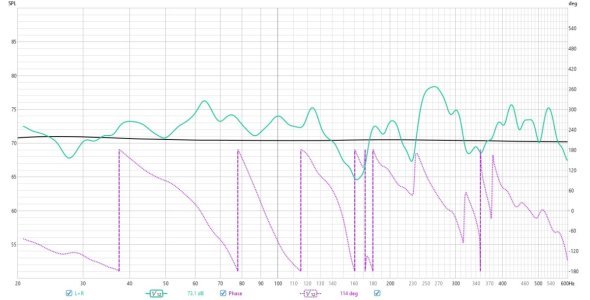
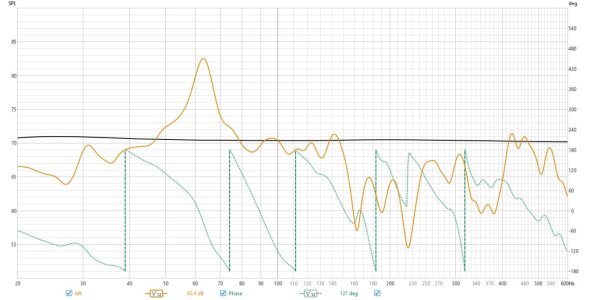
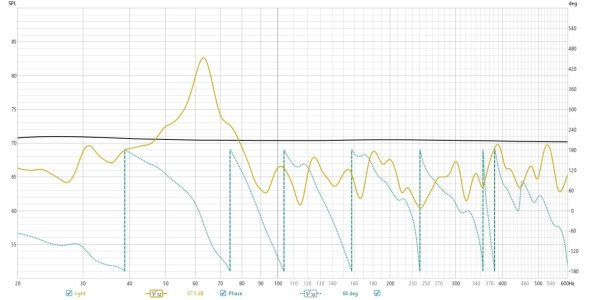
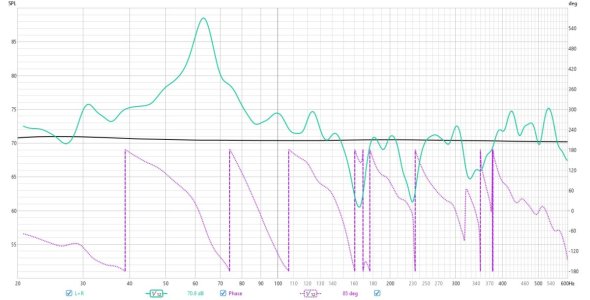
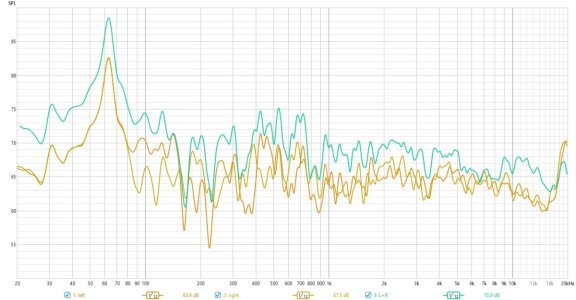
Your speakers are not phase-aligned with each other. That's why you can clearly see the dips when the phases diverge. If this issue is with the speakers themselves, I don't see how you could fix it.I really don't understand phase in REW. If I unwrap phase it varies between 1380 degrees at 20Hz and -1740 degrees at 8kHz. What does that mean?
I am not sure I trust the phase response results. I am playing the measurement sweeps from file rather than generating them directly from REW. That should be OK since they include acoustic timing chirps. If there is a delay affecting single speaker phase results I have no idea where it could be.Your speakers are not phase-aligned with each other. That's why you can clearly see the dips when the phases diverge. If this issue is with the speakers themselves, I don't see how you could fix it.
Are your speakers exactly the same distance from the wall?
And isn't there a delay between the left and right channels in the Wii settings?
There are phase-linear systems - these are the best. But that's not even the point. According to your graph, the phases diverge in certain areas. That's why dips form in the frequency response.I am not sure I trust the phase response results. I am playing the measurement sweeps from file rather than generating them directly from REW. That should be OK since they include acoustic timing chirps. If there is a delay affecting single speaker phase results I have no idea where it could be.
What does a good phase response look like in REW?
I am not sure I trust the phase response results. I am playing the measurement sweeps from file rather than generating them directly from REW. That should be OK since they include acoustic timing chirps. If there is a delay affecting single speaker phase results I have no idea where it could be.
What does a good phase response look like in REW?
Phase wraps will be introduced by the crossover(s) and by any delays added to the signal (typically caused by digital processing and by the sound propagation in air).I really don't understand phase in REW. If I unwrap phase it varies between 1380 degrees at 20Hz and -1740 degrees at 8kHz. What does that mean?
If you are measuring from a file have you made sure that it is always the same channel playing the acoustic timing chirp?I am not sure I trust the phase response results. I am playing the measurement sweeps from file rather than generating them directly from REW. That should be OK since they include acoustic timing chirps. If there is a delay affecting single speaker phase results I have no idea where it could be.
What does a good phase response look like in REW?

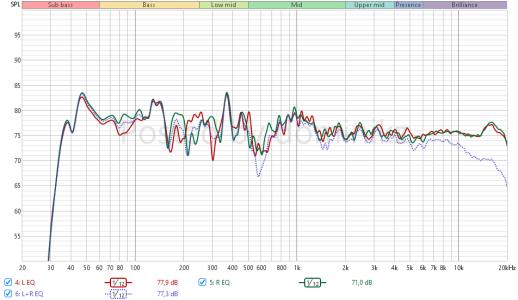
The chirp is always in the left channel.Phase wraps will be introduced by the crossover(s) and by any delays added to the signal (typically caused by digital processing and by the sound propagation in air).
If you are measuring from a file have you made sure that it is always the same channel playing the acoustic timing chirp?
E.g. regardless if you're measuring Left, Right or Left+Right channel the timing signal can always be played by e.g. the Left channel.
This is important because it will reveal any relative delays/phase-mismatches between channels.
There is IMHO no such thing as a "good phase response" shape, but phase response of both channels should ideally track each other as closely as possible.
E.g. this is how the phase plot of my desktop system looks like after EQ:
View attachment 22226
You can see the phase is pretty close in both channels throughout most of the usable bass range.
The phase wrap at around 215Hz in the right channel seems to be caused by a reflection (I suspect SBIR), and one that results in a distinct null/cancellation in the right channel:
View attachment 22227
This is the REW "Overlays" view, using the "Phase" tab - useful in this instance as it allows you to compare phase responses of multiple measurements.Which view are you using for the phase plots? I have only seen phase and SPL on the same plot with the phase scale on the right side but you have the scale on the left side.